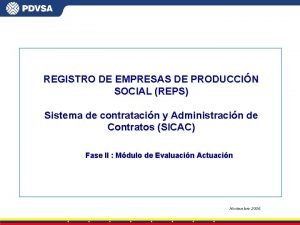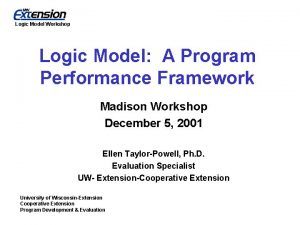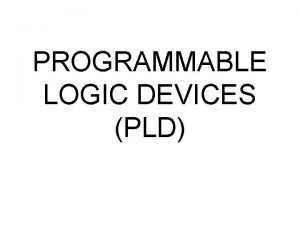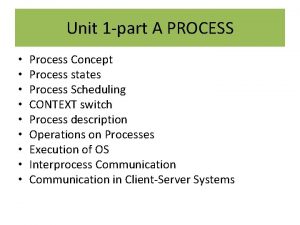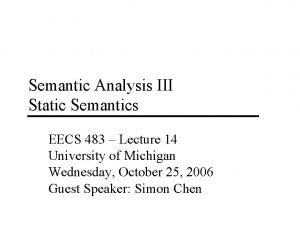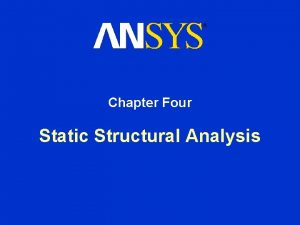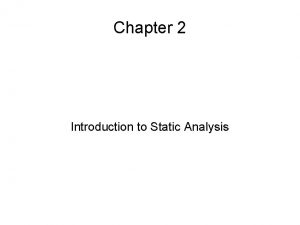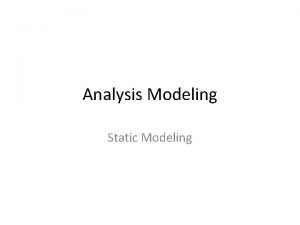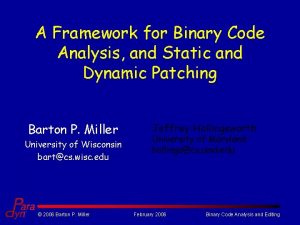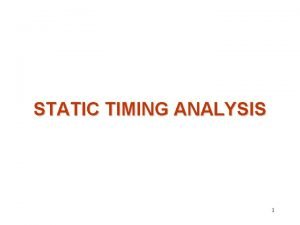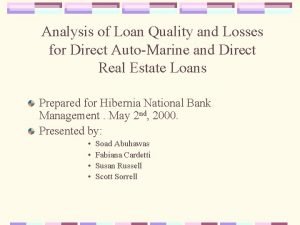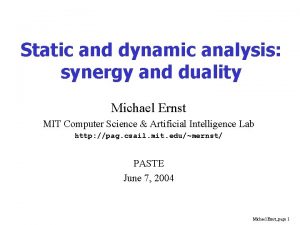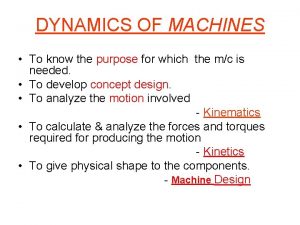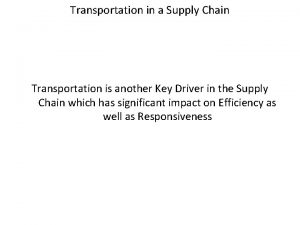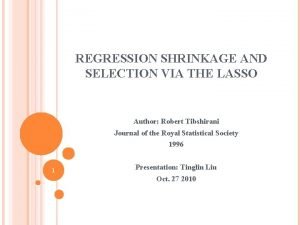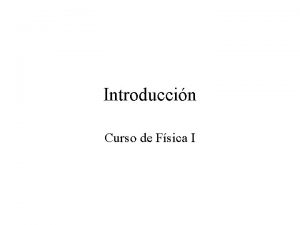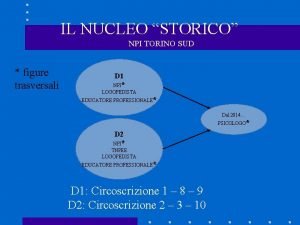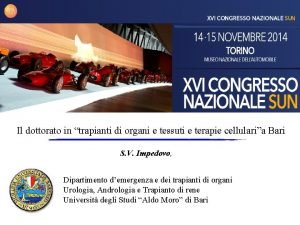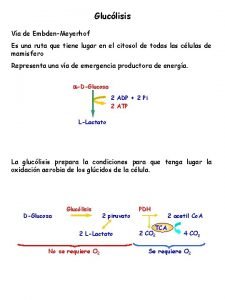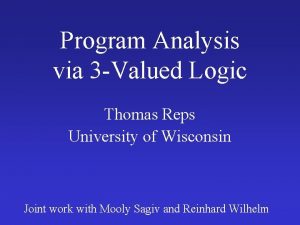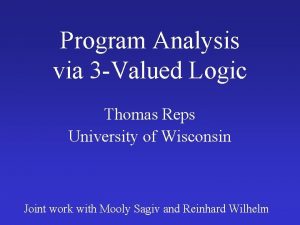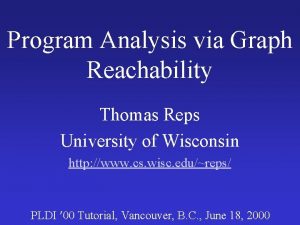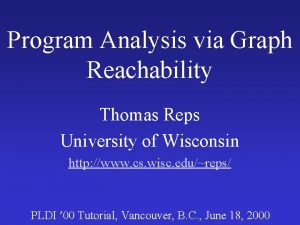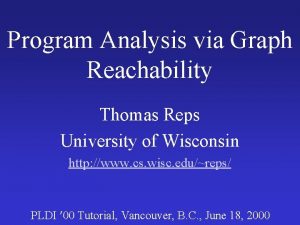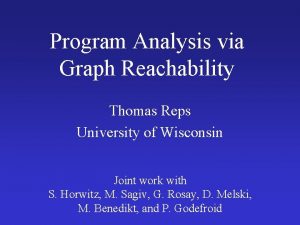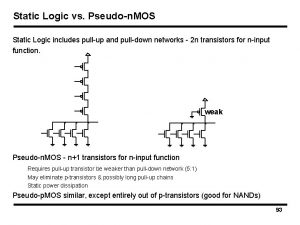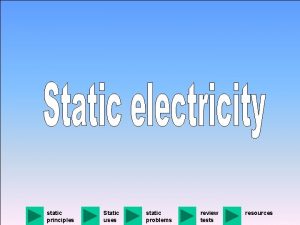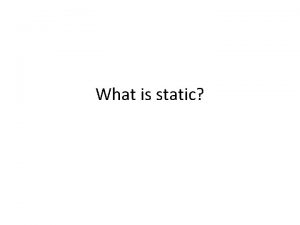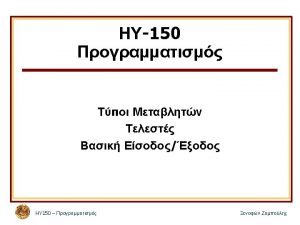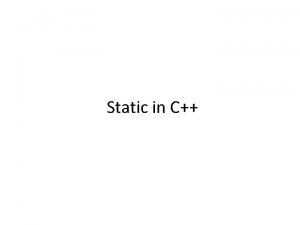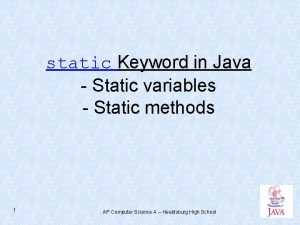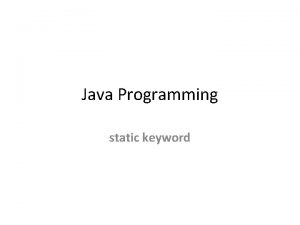Static Program Analysis via ThreeValued Logic Thomas Reps





![Shape Analysis [Jones and Muchnick 1981] • Characterize dynamically allocated data – Identify may-alias Shape Analysis [Jones and Muchnick 1981] • Characterize dynamically allocated data – Identify may-alias](https://slidetodoc.com/presentation_image_h/bcc7db88e658d183408c82b148b9236a/image-6.jpg)













































![The French Recipe for Program Verification [Cousot & Cousot] • Concrete operational semantics – The French Recipe for Program Verification [Cousot & Cousot] • Concrete operational semantics –](https://slidetodoc.com/presentation_image_h/bcc7db88e658d183408c82b148b9236a/image-52.jpg)













![Boolean Connectives [Kleene] Boolean Connectives [Kleene]](https://slidetodoc.com/presentation_image_h/bcc7db88e658d183408c82b148b9236a/image-66.jpg)




























![Updating Auxiliary Information x y t 1 }p[x], p[y]} }r[x], r[y]} }p[t 1], r[x], Updating Auxiliary Information x y t 1 }p[x], p[y]} }r[x], r[y]} }p[t 1], r[x],](https://slidetodoc.com/presentation_image_h/bcc7db88e658d183408c82b148b9236a/image-95.jpg)







- Slides: 102

Static Program Analysis via Three-Valued Logic Thomas Reps University of Wisconsin Joint work with M. Sagiv (Tel Aviv) and R. Wilhelm (U. Saarlandes)

x = 3; y = 1/(x-3); need to track values other than 0 x = 3; px = &x; y = 1/(*px-3); need to track heap-allocated storage need to track pointers x = 3; p = (int*)malloc(sizeof int); *p = x; q = p; y = 1/(*q-3);

a = &e 1 b = a 2 c = &f 3 *b = c 4 d = *a 5 a b c d a b c d e Flow-Sensitive Points-To Analysis f e f p q p = &q; p q e p f e p r 1 r 2 s 1 s 2 s 3 r 2 r 1 s 1 r 1 q p = q; p q p = *q; p r 1 r 2 q s 1 s 2 s 3 r 2 r 1 s 1 r 1 q f e f p r 2 s 2 q *p = q; p r 2 s 2 q

What About Malloc? • Each malloc site malloc-site variable int *p, *q, *r; p a: p = (int*)malloc(sizeof(int)); b: q = (int*)malloc(sizeof(int)); r = p; r q malloc$a malloc$b

What About Malloc? • Each malloc site malloc-site variable typedef struct list_cell { int val; struct list_cell *next; } *List; head p /* Create a List of length n */ List head; List *p = &head; for (int i = 0; i < n; i++) { *p = (List)malloc(sizeof(List*)); p = &((*p) next); }
![Shape Analysis Jones and Muchnick 1981 Characterize dynamically allocated data Identify mayalias Shape Analysis [Jones and Muchnick 1981] • Characterize dynamically allocated data – Identify may-alias](https://slidetodoc.com/presentation_image_h/bcc7db88e658d183408c82b148b9236a/image-6.jpg)
Shape Analysis [Jones and Muchnick 1981] • Characterize dynamically allocated data – Identify may-alias relationships – x points to an acyclic list, tree, dag, … – “disjointedness” properties • x and y point to structures that do not share cells – show that data-structure invariants hold • Account for destructive updates through pointers

Applications: Software Tools • Static detection of memory errors – dereferencing NULL pointers – dereferencing dangling pointers – memory leaks • Static detection of logical errors – Is a data-structure invariant restored?

Why is Shape Analysis Difficult? • Destructive updating through pointers – p next = q – Produces complicated aliasing relationships • Dynamic storage allocation – No bound on the size of run-time data structures • Data-structure invariants typically only hold at the beginning and end of operations – Want to verify that data-structure invariants are re-established

Example: In-Situ List Reversal typedef struct list_cell { int val; struct list_cell *next; } *List; List reverse (List x) { List y, t; y = NULL; while (x != NULL) { t = y; y = x; x = x next; y next = t; } return y; } t NULL y 1 2 x 3 NULL

Example: In-Situ List Reversal typedef struct list_cell { int val; struct list_cell *next; } *List; List reverse (List x) { List y, t; y = NULL; while (x != NULL) { t = y; y = x; x = x next; y next = t; } return y; } t NULL y 1 2 x 3 NULL

Example: In-Situ List Reversal typedef struct list_cell { int val; struct list_cell *next; } *List; List reverse (List x) { List y, t; y = NULL; while (x != NULL) { t = y; y = x; x = x next; y next = t; } return y; } t NULL y 1 2 x 3 NULL

Example: In-Situ List Reversal typedef struct list_cell { int val; struct list_cell *next; } *List; List reverse (List x) { List y, t; y = NULL; while (x != NULL) { t = y; y = x; x = x next; y next = t; } return y; } t NULL y 1 2 x 3 NULL

Example: In-Situ List Reversal typedef struct list_cell { int val; struct list_cell *next; } *List; List reverse (List x) { List y, t; y = NULL; while (x != NULL) { t = y; y = x; x = x next; y next = t; } return y; } t NULL y 1 2 x 3 NULL

Example: In-Situ List Reversal typedef struct list_cell { int val; struct list_cell *next; } *List; List reverse (List x) { List y, t; y = NULL; while (x != NULL) { t = y; y = x; x = x next; y next = t; } return y; } t NULL y 1 2 x 3 NULL

Example: In-Situ List Reversal typedef struct list_cell { int val; struct list_cell *next; } *List; List reverse (List x) { List y, t; y = NULL; while (x != NULL) { t = y; y = x; x = x next; y next = t; } return y; } t NULL y 1 2 x 3 NULL

Example: In-Situ List Reversal typedef struct list_cell { int val; struct list_cell *next; } *List; List reverse (List x) { List y, t; y = NULL; while (x != NULL) { t = y; y = x; x = x next; y next = t; } return y; } t NULL y 1 2 x 3 NULL

Example: In-Situ List Reversal typedef struct list_cell { int val; struct list_cell *next; } *List; List reverse (List x) { List y, t; y = NULL; while (x != NULL) { t = y; y = x; x = x next; y next = t; } return y; } t NULL y 1 2 x 3 NULL

Example: In-Situ List Reversal typedef struct list_cell { int val; struct list_cell *next; } *List; List reverse (List x) { List y, t; y = NULL; while (x != NULL) { t = y; y = x; x = x next; y next = t; } return y; } t NULL y 1 2 x 3 NULL

Example: In-Situ List Reversal typedef struct list_cell { int val; struct list_cell *next; } *List; List reverse (List x) { List y, t; y = NULL; while (x != NULL) { t = y; y = x; x = x next; y next = t; } return y; } t NULL y 1 2 x 3 NULL

Example: In-Situ List Reversal typedef struct list_cell { int val; struct list_cell *next; } *List; List reverse (List x) { List y, t; y = NULL; while (x != NULL) { t = y; y = x; x = x next; y next = t; } return y; } t NULL y 1 2 x 3 NULL

Example: In-Situ List Reversal typedef struct list_cell { int val; struct list_cell *next; } *List; List reverse (List x) { List y, t; y = NULL; while (x != NULL) { t = y; y = x; x = x next; y next = t; } return y; } t NULL y 1 2 x 3 NULL

Example: In-Situ List Reversal typedef struct list_cell { int val; struct list_cell *next; } *List; List reverse (List x) { List y, t; y = NULL; while (x != NULL) { t = y; y = x; x = x next; y next = t; } return y; } t NULL y 1 2 x 3 NULL

Example: In-Situ List Reversal typedef struct list_cell { int val; struct list_cell *next; } *List; List reverse (List x) { List y, t; y = NULL; while (x != NULL) { t = y; y = x; x = x next; y next = t; } return y; } t NULL y 1 2 x 3 NULL

Example: In-Situ List Reversal typedef struct list_cell { int val; struct list_cell *next; } *List; List reverse (List x) { List y, t; y = NULL; while (x != NULL) { t = y; y = x; x = x next; y next = t; } return y; } t y x

Example: In-Situ List Reversal typedef struct list_cell { int val; struct list_cell *next; } *List; List reverse (List x) { List y, t; y = NULL; while (x != NULL) { t = y; y = x; x = x next; y next = t; } return y; } t y NULL x

Example: In-Situ List Reversal typedef struct list_cell { int val; struct list_cell *next; } *List; List reverse (List x) { List y, t; y = NULL; while (x != NULL) { t = y; y = x; x = x next; y next = t; } return y; } t y NULL x

Example: In-Situ List Reversal typedef struct list_cell { int val; struct list_cell *next; } *List; List reverse (List x) { List y, t; y = NULL; while (x != NULL) { t = y; y = x; x = x next; y next = t; } return y; } t y NULL x

Example: In-Situ List Reversal typedef struct list_cell { int val; struct list_cell *next; } *List; List reverse (List x) { List y, t; y = NULL; while (x != NULL) { t = y; y = x; x = x next; y next = t; } return y; } t y NULL x Materialization

Example: In-Situ List Reversal typedef struct list_cell { int val; struct list_cell *next; } *List; List reverse (List x) { List y, t; y = NULL; while (x != NULL) { t = y; y = x; x = x next; y next = t; } return y; } t y NULL x

Example: In-Situ List Reversal typedef struct list_cell { int val; struct list_cell *next; } *List; List reverse (List x) { List y, t; y = NULL; while (x != NULL) { t = y; y = x; x = x next; y next = t; } return y; } t y NULL x

Example: In-Situ List Reversal typedef struct list_cell { int val; struct list_cell *next; } *List; List reverse (List x) { List y, t; y = NULL; while (x != NULL) { t = y; y = x; x = x next; y next = t; } return y; } t y NULL x

Example: In-Situ List Reversal typedef struct list_cell { int val; struct list_cell *next; } *List; List reverse (List x) { List y, t; y = NULL; while (x != NULL) { t = y; y = x; x = x next; y next = t; } return y; } t y NULL x

Example: In-Situ List Reversal typedef struct list_cell { int val; struct list_cell *next; } *List; List reverse (List x) { List y, t; y = NULL; while (x != NULL) { t = y; y = x; x = x next; y next = t; } return y; } t y NULL x

Example: In-Situ List Reversal typedef struct list_cell { int val; struct list_cell *next; } *List; List reverse (List x) { List y, t; y = NULL; while (x != NULL) { t = y; y = x; x = x next; y next = t; } return y; } t y NULL x

Example: In-Situ List Reversal typedef struct list_cell { int val; struct list_cell *next; } *List; List reverse (List x) { List y, t; y = NULL; while (x != NULL) { t = y; y = x; x = x next; y next = t; } return y; } t y x

Example: In-Situ List Reversal typedef struct list_cell { int val; struct list_cell *next; } *List; List reverse (List x) { List y, t; y = NULL; while (x != NULL) { t = y; y = x; x = x next; y next = t; } return y; } t y x

Example: In-Situ List Reversal typedef struct list_cell { int val; struct list_cell *next; } *List; List reverse (List x) { List y, t; y = NULL; while (x != NULL) { t = y; y = x; x = x next; y next = t; } return y; } t y x

Example: In-Situ List Reversal typedef struct list_cell { int val; struct list_cell *next; } *List; List reverse (List x) { List y, t; y = NULL; while (x != NULL) { t = y; y = x; x = x next; y next = t; } return y; } t y x

Example: In-Situ List Reversal typedef struct list_cell { int val; struct list_cell *next; } *List; List reverse (List x) { List y, t; y = NULL; while (x != NULL) { t = y; y = x; x = x next; y next = t; } return y; } t y x

Example: In-Situ List Reversal typedef struct list_cell { int val; struct list_cell *next; } *List; List reverse (List x) { List y, t; y = NULL; while (x != NULL) { t = y; y = x; x = x next; y next = t; } return y; } t y x

Example: In-Situ List Reversal typedef struct list_cell { int val; struct list_cell *next; } *List; List reverse (List x) { List y, t; y = NULL; while (x != NULL) { t = y; y = x; x = x next; y next = t; } return y; } t y x

Example: In-Situ List Reversal typedef struct list_cell { int val; struct list_cell *next; } *List; List reverse (List x) { List y, t; y = NULL; while (x != NULL) { t = y; y = x; x = x next; y next = t; } return y; } t y NULL x

Example: In-Situ List Reversal typedef struct list_cell { int val; struct list_cell *next; } *List; List reverse (List x) { List y, t; y = NULL; while (x != NULL) { t = y; y = x; x = x next; y next = t; } return y; } t y NULL x

Example: In-Situ List Reversal typedef struct list_cell { int val; struct list_cell *next; } *List; List reverse (List x) { List y, t; y = NULL; while (x != NULL) { t = y; y = x; x = x next; y next = t; } return y; } t y NULL x

Example: In-Situ List Reversal typedef struct list_cell { int val; struct list_cell *next; } *List; List reverse (List x) { List y, t; y = NULL; while (x != NULL) { t = y; y = x; x = x next; y next = t; } return y; } t y NULL x

Idea for a List Abstraction t y x t NULL y x represents t y x NULL

t x != NULL y t y NULL x t t=y x y t y NULL t x = x next t y x y t y x x t x y NULL t y x t x y t y x NULL return y y NULL y next = t x t NULL x y=x y t NULL x x x

Properties of reverse(x) • On entry, x points to an acyclic list • On each iteration, x & y point to disjoint acyclic lists • All the pointer dereferences are safe • No memory leaks • On exit, y points to an acyclic list • On exit, x = = NULL • All cells reachable from y on exit were reachable from x on entry, and vice versa • On exit, the order between neighbors in the y-list is opposite to their order in the x-list on entry

A ‘Yacc’ for Shape Analysis: TVLA • Parametric framework – Some instantiations known analyses – Other instantiations new analyses • Applications beyond shape analysis – – – Partial correctness of sorting algorithms Safety of mobile code Deadlock detection in multi-threaded programs Partial correctness of mark-and-sweep gc alg. Correct usage of Java iterators

A ‘Yacc’ for Static Analysis: TVLA • Parametric framework – Some instantiations known analyses – Other instantiations new analyses • Applications beyond shape analysis – – – Partial correctness of sorting algorithms Safety of mobile code Deadlock detection in multi-threaded programs Partial correctness of mark-and-sweep gc alg. Correct usage of Java iterators

Formalizing “. . . ” Informal: x Formal: x Summary node
![The French Recipe for Program Verification Cousot Cousot Concrete operational semantics The French Recipe for Program Verification [Cousot & Cousot] • Concrete operational semantics –](https://slidetodoc.com/presentation_image_h/bcc7db88e658d183408c82b148b9236a/image-52.jpg)
The French Recipe for Program Verification [Cousot & Cousot] • Concrete operational semantics – st : • Collecting semantics – st c: 2 2 • Abstract semantics – : 2 A, : A 2 , ( (a)) = a, ( (C)) C – st #: A A – Upper approximation • Sound results • But may produce false alarms

Using Relations to Represent Linked Lists

Using Relations to Represent Linked Lists x y u 1 u 2 u 3 u 4

Formulas: Queries for Observing Properties Are x and y pointer aliases? v: x(v) y(v)

Are x and y Pointer Aliases? Yes v: x(v) y(v) 1 = x y u 1 u 2 u 3 u 4

Predicate-Update Formulas for “y = x” • x’(v) = x(v) • y’(v) = x(v) • t’(v) = t(v) • n’(v 1, v 2) = n(v 1, v 2)

Predicate-Update Formulas for “y = x” y’(v) = x(v) x y 1 0 0 0 u 1 u 2 u 3 u 4

Predicate-Update Formulas for “x = x n” • x’(v) = v 1: x(v 1) n(v 1, v) • y’(v) = y(v) • t’(v) = t(v) • n’(v 1, v 2) = n(v 1, v 2)

Predicate-Update Formulas for “x = x n” x’(v) = v 1: x(v 1) n(v 1, v) x y 0 1 u 2 u 3 u 4

Why is Shape Analysis Difficult? • Destructive updating through pointers – p next = q – Produces complicated aliasing relationships • Dynamic storage allocation – No bound on the size of run-time data structures • Data-structure invariants typically only hold at the beginning and end of operations – Need to verify that data-structure invariants are re-established

Two- vs. Three-Valued Logic Two-valued logic 0 Three-valued logic 1 {0, 1} {0} {1} {0} {0, 1} {1} {0, 1}

Two- vs. Three-Valued Logic Two-valued logic Three-valued logic

Two- vs. Three-Valued Logic Two-valued logic 0 Three-valued logic 1 {0, 1} {0} {1}

Two- vs. Three-Valued Logic Two-valued logic 0 Three-valued logic 1 ½ 0 1 0 ½ 1 ½
![Boolean Connectives Kleene Boolean Connectives [Kleene]](https://slidetodoc.com/presentation_image_h/bcc7db88e658d183408c82b148b9236a/image-66.jpg)
Boolean Connectives [Kleene]

Canonical Abstraction x u 1 u 2 u 3 u 4 0 0 1 0 0 0 x u 1 u 234

Canonical Abstraction x u 1 u 2 u 3 u 4 x u 1 u 234

Canonical Abstraction x u 1 u 2 u 3 u 4 0 1 x u 1 u 234

Property-Extraction Principle • Questions about a family of two-valued stores can be answered conservatively by evaluating a formula in a three-valued store • Formula evaluates to 1 formula holds in every store in the family • Formula evaluates to 0 formula does not hold in any store in the family • Formula evaluates to 1/2 formula may hold in some; not hold in others

Are x and y Pointer Aliases? x y u 1 u v: x(v) y(v) 1 1 1 Yes

Is Cell u Heap-Shared? Yes u v 1, v 2: n(v 1, u) n(v 2, u) v 1 v 2 1 1

Is Cell u Heap-Shared? x y Maybe u u 1 v 1, v 2: n(v 1, u) n(v 2, u) v 1 v 2 1/2 1/2 1

The Embedding Theorem x No y v: x(v) y(v) No No Maybe u 1 y u 34 u 2 x u 1 x u 4 u 3 u 2 x u 234 y u 1234

The Embedding Theorem • If a structure B can be embedded in a structure S by an onto function f, such that basic predicates are preserved, i. e. , p. B(u 1, . . , uk) p. S (f(u 1), . . . , f(uk)) • Then every formula is preserved: – If = 1 in S, then = 1 in B – If = 0 in S, then = 0 in B – If = 1/2 in S, then could be 0 or 1 in B

Embedding x x u 1 u 2 x u 456 u 123 u 12 u 4 u 34 u 56 u 6

Canonical Abstraction: An Embedding Whose Result is of Bounded Size x u 1 u 2 u 3 u 4 x u 1 u 234

Predicate-Update Formulas for “y = x” y’(v) = x(v) Old: New: x x y u 1 u 1 u

Predicate-Update Formulas for “x = x n” x’(v) = v 1: x(v 1) n(v 1, v) New: Old: x y u u 1 0 1/2 y u 1 x u

t x != NULL 1 0 y NULL x t t=y y x u 1 NULL u x t y=x y y’(v) = x(v) NULL x x = x next y next = t return y x y u 1 u

t x != NULL y t y NULL x t t=y x y t y NULL t x = x next t y x y t y x x t x y NULL t y x t x y t y x NULL return y y NULL y next = t x t NULL x y=x y t NULL x x x

Naïve Transformer (x = x n) x y 0 1/2 Evaluate update formulas x y x’(v) = v 1: x(v 1) n(v 1, v)

Cyclic versus Acyclic Lists x 31 x u 1 71 u 91

How Are We Doing? • Conservative • Convenient • But not very precise – Advancing a pointer down a list loses precision – Cannot distinguish an acyclic list from a cyclic list

The Instrumentation Principle • Increase precision by storing the truth-value of some chosen formulas

Is Cell u Heap-Shared? u v 1, v 2: n(v 1, u) n(v 2, u) v 1 v 2

Example: Heap Sharing is(v) = v 1, v 2: n(v 1, v) n(v 2, v) v 1 v 2 x 31 71 91 is = 0 x u 1 is = 0 u is = 0

Example: Heap Sharing is(v) = v 1, v 2: n(v 1, v) n(v 2, v) v 1 v 2 x 31 71 91 is = 0 is = 10 is = 0 x u 1 u is = 0 is = 1 is = 0

Example: Cyclicity c(v) = v 1: n(v, v 1) n*(v 1, v) x 31 71 91 c=0 c == 10 is c=1 x u 1 c=0 u c=1

Is Cell u Heap-Shared? is = 0 x y No! is = 0 u u 1 v 1, v 2: n(v 1, u) n(v 2, u) v 1 v 2 1/2 1/2 1 Maybe

Formalizing “. Informal: x y Formal: x y . . ”

Formalizing “. Informal: t 1 x y Formal: t 2 x t 1 y t 2 . . ”

Formalizing “. . . ” Informal: x y Formal: reachable from variable x reachable from variable y x r[x] r[y] y

Formalizing “. Informal: . . ” t 1 x y t 2 Formal: x r[x] r[y] t 1 r[x], r[t 1] r[y], r[t 2] y t 2
![Updating Auxiliary Information x y t 1 px py rx ry pt 1 rx Updating Auxiliary Information x y t 1 }p[x], p[y]} }r[x], r[y]} }p[t 1], r[x],](https://slidetodoc.com/presentation_image_h/bcc7db88e658d183408c82b148b9236a/image-95.jpg)
Updating Auxiliary Information x y t 1 }p[x], p[y]} }r[x], r[y]} }p[t 1], r[x], r[y]} }r[t 1], r[x], r[y]} y = NULL t 1 x }p[x]} }r[x]} }p[t 1], r[x]} }r[t 1], r[x]}

Automatic Generation of Update Formulas for Instrumentation Predicates Where do we get the predicate-update formulas to update the extra predicates?

Automatic Generation of Update Formulas for Instrumentation Predicates • Originally, user provided c, st(v) – Definitions of instrumentation predicates: p(v) – Update formulas for instrumentation predicates: p, st(v) – Update formulas for core predicates: Consistently defined? Now: p, st created from p and the c, st d d

Useful Instrumentation Predicates • • • doubly-linked(v) reachable-from-variable-x(v) acyclic-along-dimension-d(v) tree(v) dag(v) AVL trees: Need FO + TC – balanced(v), left-heavy(v), right-heavy(v) –. . . but not via height arithmetic

Materialization Formal: x y x x = x n y Informal: x y x x = x n y Formal: x y x x = x n y

Naïve Transformer (x = x n) x y Evaluate update formulas x y

Best Transformer (x = x n) x y x y . . . Evaluate update formulas x y y x . . . x y y x

“Focus”-Based Transformer (x = x n) x y Focus(x n) x y “Partial ” Evaluate update formulas x y y x
 Thomas reps
Thomas reps Thomas reps
Thomas reps Representatives per state
Representatives per state Sistema reps
Sistema reps Via crucis via lucis
Via crucis via lucis Via negativa
Via negativa Cuando se hace el via lucis
Cuando se hace el via lucis Sindrome polineuritico
Sindrome polineuritico Palavras convergentes
Palavras convergentes First order logic vs propositional logic
First order logic vs propositional logic First order logic vs propositional logic
First order logic vs propositional logic First order logic vs propositional logic
First order logic vs propositional logic Combinational logic circuit vs sequential
Combinational logic circuit vs sequential Tw
Tw Software development wbs
Software development wbs Combinational logic sequential logic
Combinational logic sequential logic Combinational logic sequential logic 차이
Combinational logic sequential logic 차이 Logic chapter 3
Logic chapter 3 Cuckoo sandbox vmware image
Cuckoo sandbox vmware image Forensic anthropologist vs forensic pathologist
Forensic anthropologist vs forensic pathologist Plc training software
Plc training software It uses a condensed form of english to convey program logic
It uses a condensed form of english to convey program logic Logic model workshop
Logic model workshop Program logic formulation
Program logic formulation Kellogg foundation logic model
Kellogg foundation logic model Pld examples
Pld examples What is process concept
What is process concept When using dual symbols in a logic diagram,
When using dual symbols in a logic diagram, What is aoi logic
What is aoi logic Eecs 483
Eecs 483 Klocwork static analysis
Klocwork static analysis Conveyor dynamic analysis
Conveyor dynamic analysis What is static structural analysis
What is static structural analysis Static semantic analysis
Static semantic analysis Limitations of static analysis
Limitations of static analysis Static requirements analysis
Static requirements analysis Binary static code
Binary static code Static timing analysis examples
Static timing analysis examples Header space analysis: static checking for networks
Header space analysis: static checking for networks Static pool analysis
Static pool analysis Apatedns
Apatedns Difference between static and dynamic analysis
Difference between static and dynamic analysis Static force analysis
Static force analysis Totem thomas king
Totem thomas king Signs of the times thomas carlyle
Signs of the times thomas carlyle Message of the poem farewell liberty
Message of the poem farewell liberty Sequential program and an event-driven program?
Sequential program and an event-driven program? Program-program komputer disebut juga dengan
Program-program komputer disebut juga dengan Program tahunan adalah
Program tahunan adalah Ms excel merupakan program aplikasi pengolah
Ms excel merupakan program aplikasi pengolah Materi aplikasi pengolah angka
Materi aplikasi pengolah angka Langkah langkah memulai microsoft word
Langkah langkah memulai microsoft word Mars exploration program analysis group
Mars exploration program analysis group Nsa director's summer program
Nsa director's summer program Program contribution analysis
Program contribution analysis Bsa risk assessment tool
Bsa risk assessment tool Asea vitamins
Asea vitamins Via petrarca 80 napoli
Via petrarca 80 napoli Via columna dorsal lemnisco medial
Via columna dorsal lemnisco medial Via rectal
Via rectal Laringo
Laringo Vía intrínseca y extrínseca de la coagulación
Vía intrínseca y extrínseca de la coagulación Bilirrubina valores normales
Bilirrubina valores normales Bilirrubina valores normales
Bilirrubina valores normales Vía mesolimbica
Vía mesolimbica Milk run vs cross docking
Milk run vs cross docking Torre milano via stresa
Torre milano via stresa Receptor sensorial
Receptor sensorial Intratecale
Intratecale Via castelgomberto 73 torino
Via castelgomberto 73 torino Site:slidetodoc.com
Site:slidetodoc.com Permeabilità intestinale
Permeabilità intestinale Reflejo mediopubiano
Reflejo mediopubiano Do que miranda, amiga de via, chamava august?
Do que miranda, amiga de via, chamava august? Via berta 5 grugliasco
Via berta 5 grugliasco Konativa
Konativa Regression shrinkage and selection via the lasso.
Regression shrinkage and selection via the lasso. Vía mesolimbica
Vía mesolimbica Tipos de ictericia
Tipos de ictericia Celulas de schwann funcion
Celulas de schwann funcion Odonto system 2 via
Odonto system 2 via Enols and enolates organic chemistry
Enols and enolates organic chemistry Nuclei della base
Nuclei della base Via comunale maranda napoli
Via comunale maranda napoli Danilo dolci palermo orari segreteria
Danilo dolci palermo orari segreteria Via pettinati 46 padova
Via pettinati 46 padova Moody sdr menu
Moody sdr menu Esteban garcia la casa de los espiritus
Esteban garcia la casa de los espiritus Hematurikateter kuff
Hematurikateter kuff Ic via roma spirito santo
Ic via roma spirito santo Orden de magnitud
Orden de magnitud Fenitoina via de administracion
Fenitoina via de administracion Via acustica
Via acustica Figure equicomposte
Figure equicomposte Via alternativa complemento
Via alternativa complemento Idrocentro cornaredo
Idrocentro cornaredo Via mondolfo 7 milano
Via mondolfo 7 milano Fluidity in hci
Fluidity in hci Cefotaxima via oral
Cefotaxima via oral Via razzaboni modena
Via razzaboni modena Via de embden meyerhof
Via de embden meyerhof Training gaussian mixture models at scale via coresets
Training gaussian mixture models at scale via coresets Via indiretta gangli della base
Via indiretta gangli della base



